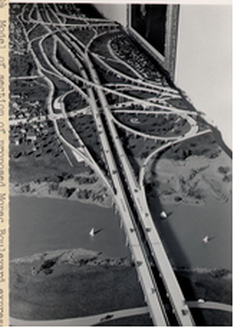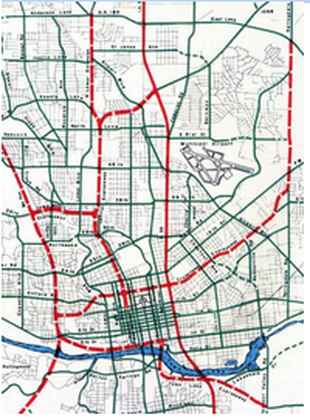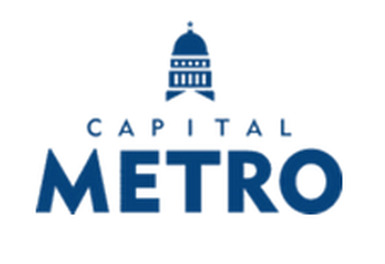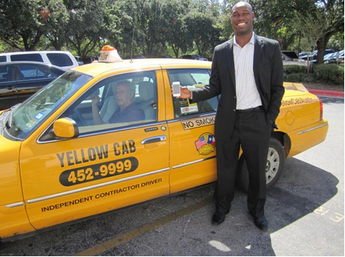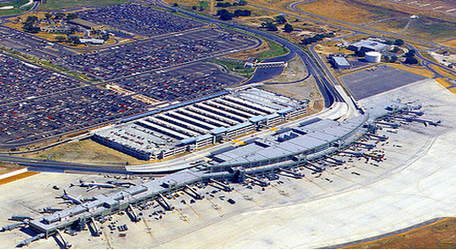Freeways
|
The electric streetcar had served people for about fifty years when with the development of cars, an extensive inner-city freeway was planned in 1962. A nameless city planner said: “I was astonished when I first saw this map. It was amazing to think of the bold vision required by the 1960's planners who routed these freeways through the center of Austin, just north of the state capitol, alongside the UT campus, along Town Lake, on Austin's narrow Guadalupe street, and through the center of downtown.[1]” This highways is certainly a bold version in 1960s because building highway seems like very difficult at that time. A great amount of workers were needed and mostly the technology problems. It was hard for local citizens to imagine highways will appear in front of their eyes. However, this freeway plan created many job opportunities for Austin residents. Since this freeway passed main traffic gathering places such as downtown and University of Texas, it helped to deal with local traffic flow and get the traffic moving.
Figure [2]. Connect ramps to freeway.
|
In 1985, a world class freeway with double loop system was planned in Austin to meet traffic flow needs since Austin became a big city that more and more people came and settled down. Also in 2000, a new freeway plan was adopted because of Austin’s explosive population growth from 1994. The Austin freeway plan expanded again [2]. Now, there are 40 highways passed Travis County, Texas[3]. |
Public Transportation
|
Capital Metro
Capital Metropolitan Transportation Authority (Capital Metro) was found in 1985. In order to provide transportation service to the metropolitan area in Austin, this company provides both bus and commuter rail for Austin residents. The daily ridership is about 130,000 which supported a great amount of Austin residents for their public transportation. [4] The logo shows a building on the top which is the Capitol building of Tex and also means primary. The logo indicated that “Capital Metro” is the primary transportation system in Austin that serves local residents. “Capital Metro uses market research to define markets, identify potential riders, and plan development of new service. The agency examines what types of inducements the potential rider pool needs to make mass transit a viable option. Origin and destination data, as well as detailed information on places and markets, are loaded into a geographical information system and analyzed[5].” This method encouraged Capital Metro to target their customers and to improve their services easily. |
Figure [3]. Capital Metro Logo.
|
Bus
Buses that serve Austin area are mainly provided by Capital Metro. The MetroBus was named E-Bus and MetroRapid was an express bus service that launched by Capital Metro in 2014. There are 82 bus routes and about 3,000 bus stops that serve the local people. The annual boarding is about 34.2 million which strongly supported the local public transportation. [6] In June 2012, Capital Metro cooperated with Austin Poetry Society to bring poetry inboard its buses. Over 150 buses featured local poets on the bus. Austin Poetry Society President Elzy Cogswell says, “APS aims to encourage more people to write poetry, to read poetry and to love poetry as we do. When we proposed this to Capital Metro, they saw how it fit with their Art in Motion project to make a daily bus ride into something new and wonderful every day. It just makes sense to bring the two together.” [7] This partnership program provided riders to read beautiful poems that wrote by local poets and encouraged poets to share their artwork to the public. Meanwhile, Capital Metro has a advertising program with both private and public partnership and this program generated more than six hundred dollars of revenue a year. Capital Metro used these revenue to continue providing convenient public transportation and create Austin transportation sustainable development.
Buses that serve Austin area are mainly provided by Capital Metro. The MetroBus was named E-Bus and MetroRapid was an express bus service that launched by Capital Metro in 2014. There are 82 bus routes and about 3,000 bus stops that serve the local people. The annual boarding is about 34.2 million which strongly supported the local public transportation. [6] In June 2012, Capital Metro cooperated with Austin Poetry Society to bring poetry inboard its buses. Over 150 buses featured local poets on the bus. Austin Poetry Society President Elzy Cogswell says, “APS aims to encourage more people to write poetry, to read poetry and to love poetry as we do. When we proposed this to Capital Metro, they saw how it fit with their Art in Motion project to make a daily bus ride into something new and wonderful every day. It just makes sense to bring the two together.” [7] This partnership program provided riders to read beautiful poems that wrote by local poets and encouraged poets to share their artwork to the public. Meanwhile, Capital Metro has a advertising program with both private and public partnership and this program generated more than six hundred dollars of revenue a year. Capital Metro used these revenue to continue providing convenient public transportation and create Austin transportation sustainable development.
Figure [4]. MetroRapid’s newest route advertising video.
|
Yellow Cab
"Before 1985, it was not unusual to have to wait two or three hours for a taxicab. I've experienced the impact of technological advancement in this industry first hand and for me it results in more trips." – Brad Ryker [8] Since the demand for taxicabs increased, a taxi company named American Cab was born in April 1985. Over 800 trips were dispatched on the first day and about 1600 trips were made by the end of the first week. In 1995, a new company named American Yellow-Checker Cab Co. was founded and later on changed name to Yellow Cab Austin. Today, more than 455 taxis are serving 97 percent of Austin’s taxi needs.[8] The Yellow Cab provided local residents to transport to other places much easier. Air travel |
Figure [5]. Yellow Cab Austin president Ed Kargbo greets a cab he hailed with the company’s app.
|
|
Figure [6]. Austin-Bergstrom International Airport.
|
Austin-Bergstrom International Airport was named after an officer Captain John August Earl Bergstrom. The airport opening to the public in 1999.[9] This airport serves 44 destinations. “A total of 10,017,958 passengers traveled through the Austin–Bergstrom International Airport in 2013, an all-time high and the first year that more than 10 million people used the airport.” [10] The Capital Metro Transportation Authority offers bus services at the airport named “Airport Flyer”. Also, the Yellow Cab provide pick up service too. Students from University of Texas main campus can take bus or yellow cab to go back to school or go to the airport. This large amount of students need transportation especially many of them came from out-states.[8] Nowadays, more and more people prefer to take plane to other cities. Austin-Bergstorm International Airport supported local and residents from other cities to easily transport from one city to another. It also brought new population to Austin.
|
Footnotes:
[1] Austin Transportation Plan, 1962-1982. Texas Highway Department. Austin, Texas: n.p., 1965. Print.
[2] Historic Austin Freeway Planning Maps. (n.d.). TexasFreeWay.
http://www.texasfreeway.com/austin/historic/freeway_planning_maps/freeway_planning_maps.shtml
[3]List of Highways in Travis, Texas. (n.d.). Wikipedia.
http://en.wikipedia.org/wiki/List_of_highways_in_Travis_County,_Texas
[4] About Capital Metro. (n.d.). Capital Metro.
http://www.capmetro.org/aboutus/
[5] Rosenbloom, S. and Fielding, G. (1998). Transit markets of the future. 1st ed. Washington, D.C.: National Academy Press.
[6] MetroBus. (n.d.). Capital Metro.
http://www.capmetro.org/metrobus/
[7] Capmetro.org. June 6, 2012. Partnership brings beauty and art to the bus.
http://www.capmetro.org/news-item.aspx?id=1156&terms=partnership
[8] Building Success: History of Service and Investment. 2012. Yellow Cab Austin.
http://www.yellowcabaustin.com/AboutUs.aspx
[9] History of the airport. (n.d.). Austin-Bergstrom International Airport. Retrieved from
http://www.austintexas.gov/department/history-airport
[10] Ayala-Talavera, Monica. January 30, 2014. ABIA saw a record 10 million passenger in 2013. Retrieved from
http://kxan.com/2014/01/30/abia-saw-a-record-10-million-passengers-in-20
MEDIA:
[M1] Central area freeways.
http://www.texasfreeway.com/austin/historic
[M2]. Connect ramps to freeway.
http://www.texasfreeway.com
[M3]. Capital Metro Logo.
http://www.capmetro.org
[M4]. MetroRapid’s newest route advertising video.
https://www.youtube.com/watch?v=VbsEXK-1FNc
[M5]. Yellow Cab Austin president Ed Kargbo greets a cab he hailed with the company’s app.
http://yellowcabhouston.wordpress.com
[M6]. Austin-Bergstrom International Airport.
http://are320k.wordpress.com
[1] Austin Transportation Plan, 1962-1982. Texas Highway Department. Austin, Texas: n.p., 1965. Print.
[2] Historic Austin Freeway Planning Maps. (n.d.). TexasFreeWay.
http://www.texasfreeway.com/austin/historic/freeway_planning_maps/freeway_planning_maps.shtml
[3]List of Highways in Travis, Texas. (n.d.). Wikipedia.
http://en.wikipedia.org/wiki/List_of_highways_in_Travis_County,_Texas
[4] About Capital Metro. (n.d.). Capital Metro.
http://www.capmetro.org/aboutus/
[5] Rosenbloom, S. and Fielding, G. (1998). Transit markets of the future. 1st ed. Washington, D.C.: National Academy Press.
[6] MetroBus. (n.d.). Capital Metro.
http://www.capmetro.org/metrobus/
[7] Capmetro.org. June 6, 2012. Partnership brings beauty and art to the bus.
http://www.capmetro.org/news-item.aspx?id=1156&terms=partnership
[8] Building Success: History of Service and Investment. 2012. Yellow Cab Austin.
http://www.yellowcabaustin.com/AboutUs.aspx
[9] History of the airport. (n.d.). Austin-Bergstrom International Airport. Retrieved from
http://www.austintexas.gov/department/history-airport
[10] Ayala-Talavera, Monica. January 30, 2014. ABIA saw a record 10 million passenger in 2013. Retrieved from
http://kxan.com/2014/01/30/abia-saw-a-record-10-million-passengers-in-20
MEDIA:
[M1] Central area freeways.
http://www.texasfreeway.com/austin/historic
[M2]. Connect ramps to freeway.
http://www.texasfreeway.com
[M3]. Capital Metro Logo.
http://www.capmetro.org
[M4]. MetroRapid’s newest route advertising video.
https://www.youtube.com/watch?v=VbsEXK-1FNc
[M5]. Yellow Cab Austin president Ed Kargbo greets a cab he hailed with the company’s app.
http://yellowcabhouston.wordpress.com
[M6]. Austin-Bergstrom International Airport.
http://are320k.wordpress.com
